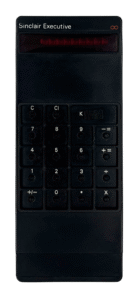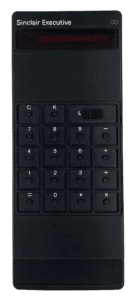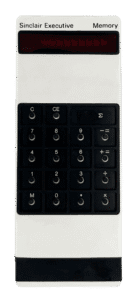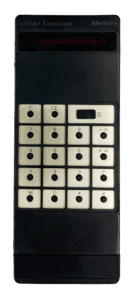Executive (1972-73)

Executive was the world’s first slimline pocket-sized electronic calculator. Just 9 mm thick, it fit neatly in a shirt pocket—one third the size of its rivals and half the cost. This early model featured a “K” switch for constants and a side-mounted control for fixing or floating decimal places. To achieve its slim form, Sinclair developed a circuit that supplied power to the calculator’s chip in short pulses rather than continuously—cutting energy use and allowing the calculator to run on tiny button cells at a time when most calculators required larger batteries or mains power.

A later version of the innovative Executive, this model introduced a brightness switch “L”/“H” and replaced the “K” constant switch with a dedicated button—small refinements that made it easier to use. Beneath its casing, the Executive’s breakthrough lay in its pulsed-power circuitry, which supplied energy to the chip only when needed. This radical approach reduced energy use and allowed for a slimmer design than any rival. The Executive series won a Design Council Award in 1973, and an example is held in the Museum of Modern Art’s collection in in New York for its technical innovation and contribution to modern design.

This slim calculator added a memory function to the original Executive—allowing users to store subtotals during sequences of calculations. Like its predecessor, it used pulsed-power circuitry to run on four button cells, keeping the case just 9 mm thick. Introduced at a lower price than the original Executive, it featured a red LED display and a Texas Instruments chip that handled its calculations and display. This model combined a white plastic case with a brushed black metal faceplate, in keeping with the range’s award-winning design aesthetic.

This follow-up to the original Executive added a memory function while preserving the ultra-slim 9 mm profile. It used the same reduced power intake to run on four button cells—remarkably compact for its time—powering a red LED display and Texas Instruments chip. This version featured a black metal case with a gold-toned faceplate and black buttons, giving it a more luxurious, high-contrast look. These refinements reflected the Executive range’s focus on usability, upgraded features, and modern design.
